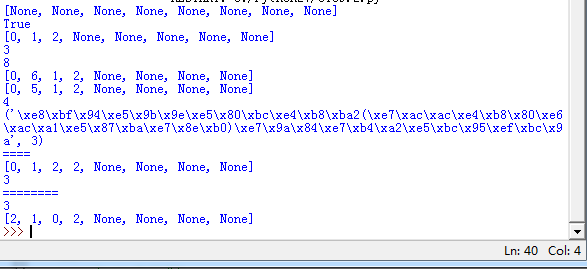溫馨提示×
您好,登錄后才能下訂單哦!
點擊 登錄注冊 即表示同意《億速云用戶服務條款》
您好,登錄后才能下訂單哦!
小編給大家分享一下Python中順序表怎么實現,相信大部分人都還不怎么了解,因此分享這篇文章給大家參考一下,希望大家閱讀完這篇文章后大有收獲,下面讓我們一起去了解一下吧!
順序表python版的實現(部分功能未實現)
結果展示:

代碼示例:
#!/usr/bin/env python
# -*- coding:utf-8 -*-
class SeqList(object):
def __init__(self, max=8):
self.max = max #創建默認為8
self.num = 0
self.date = [None] * self.max
#list()會默認創建八個元素大小的列表,num=0,并有鏈接關系
#用list實現list有些荒謬,全當練習
#self.last = len(self.date)
#當列表滿時,擴建的方式省略
def is_empty(self):
return self.num is 0
def is_full(self):
return self.num is self.max
#獲取某個位置的元素
def __getitem__(self, key):
if not isinstance(key, int):
raise TypeError
if 0<= key < self.num:
return self.date[key]
else:
#表為空或者索引超出范圍都會引發索引錯誤
raise IndexError
#設置某個位置的元素
def __setitem__(self, key, value):
if not isinstance(key, int):
raise TypeError
#只能訪問列表里已有的元素,self.num=0時,一個都不能訪問,self.num=1時,只能訪問0
if 0<= key < self.num:
self.date[key] = value #該位置無元素會發生錯誤
else:
raise IndexError
def clear(self):
self.__init__()
def count(self):
return self.num
def __len__(self):
return self.num
#加入元素的方法 append()和insert()
def append(self,value):
if self.is_full():
#等下擴建列表
print("list is full")
return
else:
self.date[self.num] = value
self.num += 1
def insert(self,key,value):
if not isinstance(key, int):
raise TypeError
if key<0: #暫時不考慮負數索引
raise IndexError
#當key大于元素個數時,默認尾部插入
if key>=self.num:
self.append(value)
else:
#移動key后的元素
for i in range(self.num, key, -1):
self.date[i] = self.date[i-1]
#賦值
self.date[key] = value
self.num += 1
#刪除元素的操作
def pop(self,key=-1):
if not isinstance(key, int):
raise TypeError
if self.num-1 < 0:
raise IndexError("pop from empty list")
elif key == -1:
#原來的數還在,但列表不識別他
self.num -= 1
else:
for i in range(key,self.num-1):
self.date[i] = self.date[i+1]
self.num -= 1
def index(self,value,start=0):
for i in range(start, self.num):
if self.date[i] == value:
return i
#沒找到
raise ValueError("%d is not in the list" % value)
#列表反轉
def reverse(self):
i,j = 0, self.num - 1
while i<j:
self.date[i], self.date[j] = self.date[j], self.date[i]
i,j = i+1, j-1
if __name__=="__main__":
a = SeqList()
print(a.date)
#num == 0
print(a.is_empty())
a.append(0)
a.append(1)
a.append(2)
print(a.date)
print(a.num)
print(a.max)
a.insert(1,6)
print(a.date)
a[1] = 5
print(a.date)
print(a.count())
print("返回值為2(第一次出現)的索引:", a.index(2, 1))
print("====")
t = 1
if t:
a.pop(1)
print(a.date)
print(a.num)
else:
a.pop()
print(a.date)
print(a.num)
print("========")
print(len(a))
a.reverse()
print(a.date)
"""
print(a.is_full())
a.clear()
print(a.date)
print(a.count())
"""以上是“Python中順序表怎么實現”這篇文章的所有內容,感謝各位的閱讀!相信大家都有了一定的了解,希望分享的內容對大家有所幫助,如果還想學習更多知識,歡迎關注億速云行業資訊頻道!
免責聲明:本站發布的內容(圖片、視頻和文字)以原創、轉載和分享為主,文章觀點不代表本網站立場,如果涉及侵權請聯系站長郵箱:is@yisu.com進行舉報,并提供相關證據,一經查實,將立刻刪除涉嫌侵權內容。